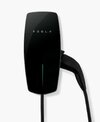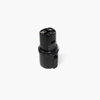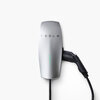Notes:
With the continued influx of new Tesla (especially Models 3 and Y) owners, questions continue about the best way to charge at home. Here is a modest decision-making chart.
 Notes
Notes
Readers can see where charging-connector options (1-6/7), from Chart 1, fit diagrammatically within a typical home charging system in this revised figure (taken from Post #13, below):
 Notes for each category are in Post #13. A few additional comments:
Notes for each category are in Post #13. A few additional comments:
March 29, 2023 Update: As time passes, I repeatedly see posts on the Internet by (frequently new) Tesla owners asking for advice about home charging options. Besides the information included above, here is a third chart that attempts to capture ballpark order-of-magnitude equipment-cost estimates associated with some of the most common options for 240-volt charging at home.

Note: Costs quoted above clearly do not include labor, which can be sizeable and vary widely. They also ignore sales tax, shipping costs, online discounts, and other factors that can increase or decrease prices. For wiring estimates I arbitrarily assumed a 40-foot run. For a NEMA 14-50 receptacle, I assumed a Hubbell commercial-grade device. (A NEMA 14-60 receptacle is usually going to be a good-quality, commercial-grade brand.) And if you question that higher-rated breakers appear to cost less than smaller ones, I can't really explain it. Breaker price differences quoted here may be artificial (not real), or they may reflect demand or lack thereof. More importantly, what definitely is true is that GFI breakers cost a lot more than standard breakers (possibly for no defensible reason).
So equipment cost estimates quoted here are very crude (I simply snatched prices on Google for Home Depot and the like). New in this version are prices for a 60-amp wall-outlet system. The expense for that (arguably unnecessary charging option) is mainly due to a pricey (new to me) NEMA 14-60 charging cable (that requires a J1772 adapter). Custom 60a cables (with a Tesla plug end) might be just as expensive.
Regardless, there is at least one possible take-away to all this:
Admittedly, installation details (and costs) may vary greatly from home to home, region to region, and state to state. However, in my humble opinion, otherwise unjustifiably large markups by electricians for installations at Tesla households should be a thing of the past. Furthermore, with all things equal, bids should not vary that much between wall outlet and (the arguably superior) wall connector systems.
- If you are curious about the historic availability and cost of Tesla charging accessories, see these posts for (a) key milestones (dates) about and (b) a more detailed price history for USA Tesla charge accessories.
| - Coming in October 2023--an exciting new Tesla "Universal" Wall Connector that will include an integrated J1772 adapter that fits onto the standard (once proprietary, now "North American Charging Standard") Tesla plug, so a user can easily and conveniently charge both Tesla and non-Tesla cars (with J1772 ports) using the same wall connector cable (and with no need for a separate, easily mislaid, J1772 adapter). I assume that this new wall connector will be Generation 3-based (e.g., with 48a maximum), and that it will replace Tesla's J1772 WC. See report here plus Tesla website info here.)
With the continued influx of new Tesla (especially Models 3 and Y) owners, questions continue about the best way to charge at home. Here is a modest decision-making chart.
- A first decision is often whether to charge your car at 120 or 240 volts. Advantages of the higher voltage are well-documented in this Forum, on the Tesla website, and by many other online sources. If only 120-volt charging is available Tesla supplies a 12-amp NEMA 5-15 Adapter plug with the Gen 2 Mobile Connector that comes with the car. Connected to a standard 15-amp grounded wall outlet, it supplies about 2 to 3 miles worth of stored energy per hour of charging. An optional 16-amp NEMA 5-20 Adapter plug ($35) on a 20-amp house circuit provides 3 to 4 miles of travel energy per charge-hour. (The 240-volt connectors are able to contribute to much faster rates of charging.)
- The next choice is seemingly between the exclusive use of Tesla products and similar devices made by other companies. In practice, users may delay that decision, continue through the steps to select from among Options 1-6, and consider both Tesla and equivalent "aftermarket" devices at that point.
There are several well-known brands of non-Tesla wall connectors--e.g., Clipper Creek, ChargePoint, and Juice Box spring to mind. There are others, with some made in America. The better ones are not cheap. The precursors to today's home charging devices were around in the decade before Tesla--since at least the General Motors EV1-days of the 1990s. These products service increasing numbers of both non-Tesla and Tesla plug-in vehicles.
Both Tesla (Models S, Ǝ, X, and Y) and non-Tesla electric car owners can use this chart by swapping in equivalent non-Tesla products in place of the ones mentioned. Note that unless specifically made for Tesla vehicles, most non-Tesla charge connectors require use of the J1772 Adapter, supplied with each new car, in order to connect to a Tesla. (Note also that this chart is not intended for the original Tesla Roadster.)
- Option 1: For the budget-minded, the (as of 4/28/22) $200, up to 32-amp Gen 2 Mobile Connector (MC) comes with a 20-foot cable. And as of 4/28/22 the 240-volt NEMA 14-50 plug-adapter will once again be included in the Gen 2 Mobile Connector bundle. To plug into other types of 240-volt wall outlets, purchase one of five additional types of (12a to 32a) Tesla NEMA Adapters ($35-$45), with additional aftermarket adapters available.
Not shown is the original Tesla Universal Mobile Connector (with its Generation 1 NEMA Adapters). The UMC is an up to 40-amp device, but for decision-making purposes is otherwise similar to the Gen 2 MC (Options 1 & 2). The UMC is no longer sold by Tesla.
- Option 2: Some drivers purchase a second MC as a solely-dedicated home connecting device. An additional Gen 2 MC and Adapter now cost $200-$235/$245 (depending on whether a third 240v adapter-plug--besides the included NEMA 5-15 and 14-50 plugs--is needed).
- Option 3: The Corded Mobile Connector has a 20-foot cable and sells for
$520$400$200 (when in stock) from Tesla. It is similar in appearance to the Gen 2 MC, but is all one-piece, has a permanent NEMA 14-50 plug end, and is a Gen 1 (up to 40-amp) connector.
Having a second mobile (or a single wall) connector helps alleviate wear-and-tear on the original Gen 2 MC, and allows it to be kept stored in the car for on-the-road use. It also means that the second mobile connector can be kept more-or-less permanently plugged into the wall socket (with cable neatly stored on a convenient hanger), alleviating the real danger of cumulative in/out wear to the socket, and reducing any (even minor) risk of accidental shock.
- Option 4: Tesla briefly offered the NEMA 14-50 Wall Connector (2019-20) with either an 8½ or 24-foot cable. They originally cost $500, but are no longer offered by the Company.
- Option 5: The 48-amp Gen 3 Wall Connector is the latest version from Tesla. As of 2022 it comes with either an 8½ or 24-foot cable for
$550$400. (Earlier versions had either 8½ or 18-foot cables.)
- Option 6: The 80-amp Gen 2 High Power Wall Connector came from Tesla, with either an 8½ or 24-foot cable, for $500.
Not illustrated, the Gen 1 Wall Connector is similar to the Gen 2 Wall Connector (Option 6). However, Gen 1 WCs lack the charge-sharing feature and therefore cannot be electrically linked to charge up to 4 cars simultaneously off of one circuit, as can Gen 2 WCs. Neither the Gen 1 or Gen 2 WCs are currently sold by Tesla. But Gen 2 devices may still be found online, new or used.
- Option 7 (not illustrated in Chart 1): Do you also need to charge a non-Tesla car? As of October 2022 a new Tesla J1772 Gen 3 Wall Connector is now advertised on the Tesla North American Charging websites (in Canada for $733[CAN] and the USA for $550[US]). (A Gen 2 version was previously offered for $415[US] for about a month [in North America] starting around November 2021.) This hardwired (to the house circuitry) 240-volt wall connector will, I assume like the standard Gen 3 WC, provide up to 48 amps on a maximum 60-amp circuit to cars with a J1772 port, which means most North American non-Tesla electric vehicles. A J17772 adapter (included with most new Tesla cars, or $50 on the Tesla site) will allow it to also charge a Tesla. It also has a 24-foot cable, but naturally with a J1772 end-plug. Tesla Gen 2 J1772 wall connectors are probably hard to find, but possibly still available in the used-item markets.
Readers can see where charging-connector options (1-6/7), from Chart 1, fit diagrammatically within a typical home charging system in this revised figure (taken from Post #13, below):
- Circuit Breaker - I've been prompted to remind readers that for safety GFI (or GFCI) circuit breakers, like the one pictured in Chart 2, are required under Code for certain circumstances and locations when installing electrical wall outlets used in car-charging systems. (Tesla Wall connectors have protective ground fault interruption circuitry built in, I believe.) Check with your local permitting authorities about this.
- Connecting Cable - Tesla (and non-Tesla) connection devices come with different cable lengths; for Tesla the choices have been 8½-, 18-, 20-, or 24-feet (see first chart, above). Plan accordingly, check the device specs, and choose the right cable length for your particular situation.
*****
March 29, 2023 Update: As time passes, I repeatedly see posts on the Internet by (frequently new) Tesla owners asking for advice about home charging options. Besides the information included above, here is a third chart that attempts to capture ballpark order-of-magnitude equipment-cost estimates associated with some of the most common options for 240-volt charging at home.
Note: Costs quoted above clearly do not include labor, which can be sizeable and vary widely. They also ignore sales tax, shipping costs, online discounts, and other factors that can increase or decrease prices. For wiring estimates I arbitrarily assumed a 40-foot run. For a NEMA 14-50 receptacle, I assumed a Hubbell commercial-grade device. (A NEMA 14-60 receptacle is usually going to be a good-quality, commercial-grade brand.) And if you question that higher-rated breakers appear to cost less than smaller ones, I can't really explain it. Breaker price differences quoted here may be artificial (not real), or they may reflect demand or lack thereof. More importantly, what definitely is true is that GFI breakers cost a lot more than standard breakers (possibly for no defensible reason).
So equipment cost estimates quoted here are very crude (I simply snatched prices on Google for Home Depot and the like). New in this version are prices for a 60-amp wall-outlet system. The expense for that (arguably unnecessary charging option) is mainly due to a pricey (new to me) NEMA 14-60 charging cable (that requires a J1772 adapter). Custom 60a cables (with a Tesla plug end) might be just as expensive.
Regardless, there is at least one possible take-away to all this:
When all is said and done, and thanks in part to new Tesla charge-equipment pricing, the total cost of parts for a wall-connector system is not that different from the price of a wall-outlet setup. And in my (modest) experience, the physical effort to install a wall connector is really no greater, and may actually be less than what is required for a wall outlet (given that the labor to deal with upstream house circuitry is equivalent).
Admittedly, installation details (and costs) may vary greatly from home to home, region to region, and state to state. However, in my humble opinion, otherwise unjustifiably large markups by electricians for installations at Tesla households should be a thing of the past. Furthermore, with all things equal, bids should not vary that much between wall outlet and (the arguably superior) wall connector systems.
Attachments
Last edited:






